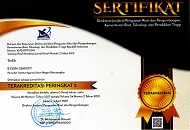DEVELOPMENT OF MATHEMATICS TEACHINGS BASED ON APOS THEORY: CONSTRUCTION OF UNDERSTANDING THE CONCEPT OF STUDENT STRAIGHT LINE EQUATION
Abstract
Keywords
Full Text:
PDF (English)References
Arslan, H., Canli, M., & Sabo, H. M. (2012). A research of the effect of attitude, achievement, and gender on mathematic education. Acta Didactica Napocensia, 5(1), 45-52.
Arnon, I., Cottrill, J., Dubinsky, Ed., Oktac, A., Fuentes, S. R., Trigueros, M. Dan Willer, K.., 2014. APOS Theory A Framework arnafor Research and Currculum Development in Mathematics Education. Now Yok: Spinger Heidelberg Dordrecht. London.
Astra, I. M., Nasbey, H., & Nugraha, A. (2015). Development of an android application in the form of a simulation lab as learning media for senior high school students. Eurasia Journal of Mathematics, Science and Technology Education, 11(5), 1081-1088.
Asrial., Syahrial., Kurniawan, D. A., Perdana, R., Nugroho, P. (2019). Supporting Technologi 4.0: Ethnoconstructivist Multimedia for Elementary Schools. International Journal of Online and Biomedical Engineering (iJOE). 15(9), 4-15
Asrial., Syahrial., Kurniawan, D. A., Subandiyo, M., Amalina, N. (2019). Exploring obstacles in language learning among prospective primary school teacher. International Journal of Evaluation and Research in Education (IJERE), 8(2), 249-254
Branch, R. M. (2009). Instructional design: The ADDIE approach (Vol. 722). Springer Science & Business Media
Danielsson, K., & Wiberg, C. (2006). Participatory design of learning media: Designing educational computer games with and for teenagers. Interactive Technology and Smart Education.
Dubinsky, E., & McDonald, M. A. (2001). APOS: A constructivist theory of learning in undergraduate mathematics education research. In The teaching and learning of mathematics at university level (pp. 275-282). Springer, Dordrecht.,
Dubinsky, E., Weller, K., Mcdonald, M. A., & Brown, A. (2005). Some historical issues and paradoxes regarding the concept of infinity: An APOS-based analysis: Part 1. Educational studies in mathematics, 58(3), 335-359.
Fajri, K., & Taufiqurrahman, T. (2017). Pengembangan Buku Ajar Menggunakan Model 4D dalam Peningkatan Keberhasilan Pembelajaran Pendidikan Agama Islam. Jurnal Pendidikan Islam Indonesia, 2(1), 1-15.
Fischer, L., Ernst, D., & Mason, S. L. (2017). Rating the quality of open textbooks: How reviewer and text characteristics predict ratings. International Review of Research in Open and Distributed Learning, 18(4), 142-154.
Haryanto., Asrial., Ernawati, M. D. W. (2020). E-Worksheet for science processong skills using kvisoft flipnook. international journal of online and biomedical engineering, 16(3), 46-59
Herawaty, D., Widada, W., Handayani, S., Febrianti, R., & Anggoro, A. F. (2020). Students’ obstacles in understanding the properties of the closed sets in terms of the APOS theory. JPhCS, 1470(1), 012068
Lee, J., Lin, L., & Robertson, T. (2012). The impact of media multitasking on learning. Learning, Media and Technology, 37(1), 94-104.
Maison., Darmaji., Astalini., Kurniawan, D. A., Sumaryanti., Perdana, R. (2020). Supporting Assessment in Education: E-Assessment Interest in Physics. Universal Journal of Education Research, 8(1) 89-97
Maharaj, A. (2013). An APOS analysis of natural science students’ understanding of derivatives. South African Journal of Education, 33(1).
Maharaj, A. (2010). An APOS analysis of students' understanding of the concept of a limit of a function. Pythagoras, 2010(71), 41-52.
Martono, K. T., & Nurhayati, O. D. (2014). Implementation of android based mobile Learning application as a flexible learning Media. International Journal of Computer Science Issues (IJCSI), 11(3), 168.
Meyer, L. A., Crummey, L., & Greer, E. A. (1988). Elementary science textbooks: Their contents, text characteristics, and comprehensibility. Journal of Research in Science Teaching, 25(6), 435-463.
Mikk, J., & Luik, P. (2003). Characteristics of multimedia textbooks that affect post‐test scores. Journal of Computer Assisted Learning, 19(4), 528-537.
Montag, J. L., Jones, M. N., & Smith, L. B. (2015). The words children hear: Picture books and the statistics for language learning. Psychological Science, 26(9), 1489-1496.
Mukundan, J., & Khojasteh, L. (2011). Modal auxiliary verbs in prescribed Malaysian English textbooks. English Language Teaching, 4(1), 79-89.
Nari, N. (2011). Kemampuan Pemahaman Konsep Matematika dengan menerapkan Pendekatan Pembelajaran Kontekstual melalui Model Pembelajaran Kooperatif Think–Pair–Share berempat dan Kemunculan Komponen Pembelajaran Kontekstual. Ta'dib, 14(1), 26-35.
Nicol, C. C., & Crespo, S. M. (2006). Learning to teach with mathematics textbooks: How preservice teachers interpret and use curriculum materials. Educational studies in mathematics, 62(3), 331-355.
Nodelman, P. (2001). A is for... what? The function of alphabet books. Journal of Early Childhood Literacy, 1(3), 235-253.
Parraguez, M., & Oktaç, A. (2010). Construction of the vector space concept from the viewpoint of APOS theory. Linear algebra and its applications, 432(8), 2112-2124.
Penney, K., Norris, S. P., Phillips, L. M., & Clark, G. (2003). The anatomy of junior high school science textbooks: An analysis of textual characteristics and a comparison to media reports of science. Canadian Journal of Science, Mathematics and Technology Education, 3(4), 415-436.
Richey, R. C., & Klein, J. D. (2007). Design and development research. Mahwah, NJ.
Rofiki, I., Anam, A. C., Sari, P. E., Irawan, W. H., & Santia, I. (2020). Students’ Mental Construction in Cube and Cuboid Concepts Based on Mathematical Ability Differences. Al-Jabar: Jurnal Pendidikan Matematika, 11(1), 133-144.
Salgado, H., & Trigueros, M. (2015). Teaching eigenvalues and eigenvectors using models and APOS Theory. The Journal of Mathematical Behavior, 39, 100-120.
Shin, J., Eslami, Z. R., & Chen, W. C. (2011). Presentation of local and international culture in current international English-language teaching textbooks. Language, Culture and Curriculum, 24(3), 253-268.
Syaiful., Kamid., Muslim., Huda, N. (2019). Investigate the relationship of creative thinking skills and junior high school students motivation. Humanities & Social Science Reviews, 8(2), 159-167
Yunita, A. (2014). Pengaruh Metode Stratagem Melalui Pembelajaran Kooperatif Terhadap Pemahaman Konsep Matematis Siswa Kelas Viii Smp Negeri 20 Padang. Ta'dib, 17(1), 25-36.
DOI: http://dx.doi.org/10.31958/jt.v24i1.2346
Refbacks
- There are currently no refbacks.
Copyright (c) 2021 Kamid

This work is licensed under a Creative Commons Attribution-NonCommercial-NoDerivatives 4.0 International License.
TA'DIB with registered number e-ISSN: 2580-2771, p-ISSN: 1410-8208 have been indexed on:

Journal Ta'dib distribute under Lisensi Creative Commons Atribusi-NonKomersial 4.0 Internasional.
Contact us: Ta'dib; Address: FTIK, Universitas Islam Negeri Mahmud Yunus Batusangkar; Jl. Sudirman No. 137 Lima Kaum Batusangkar, Tanah Datar, Sumatera Barat, Indonesia. Email: takdib@uinmybatusangkar.ac.id

























